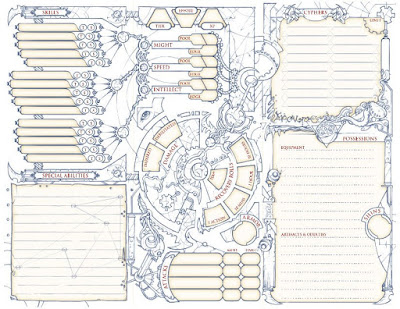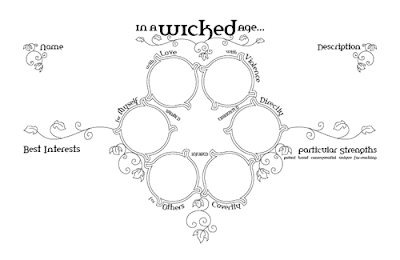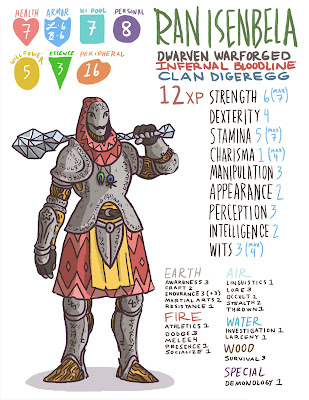"Govannion discovered and set down the high secrets of all crafts. These Arawn stole to hoard in Annuvin where none may ever profit from them." The potter Annlaw's face turned grave. "A lifetime have I striven to discover them again, to guess what might have been their nature. Much have I learned--learned by doing, as a child learns to walk. But my steps falter. The deepest lore yet lies beyond my grasp. I fear it ever shall. Let me gain this lore," Annlaw said, "and I'll yearn for no magical tools. Let me find the knowledge. And these," he added, holding up his clay-crusted hands, "these will be enough to serve me."
Annlaw drew up his coarse robe and seated himself at the wheel, which he quickly set spinning, and on it flung a lump of clay. The potter bent almost humbly to his work, and reached out his hands as tenderly as if he were lifting an unfledged bird. Before Taran's eyes Annlaw began shaping a tall slender vessel. As Taran stared in awe, the clay seemed to shimmer on the swiftly turning wheel and to change from moment to moment. Now Taran understood Annlaw's words, for indeed between the potter's deft fingers and the clay he saw no separation, as though Annlaw's hands flowed into the clay and gave it life. Annlaw was silent and intent; his lined face had brightened; the years had fallen away from it. Taran felt his heart fill with a joy that seemed to reach from the potter to himself, and in that moment understood that he was in the presence of a true master craftsman, greater than any he had ever know. "Fflewddur was wrong," Taran murmured, "If there is enchantment, it lies not in the potter's wheel but in the potter."
Annlaw drew up his coarse robe and seated himself at the wheel, which he quickly set spinning, and on it flung a lump of clay. The potter bent almost humbly to his work, and reached out his hands as tenderly as if he were lifting an unfledged bird. Before Taran's eyes Annlaw began shaping a tall slender vessel. As Taran stared in awe, the clay seemed to shimmer on the swiftly turning wheel and to change from moment to moment. Now Taran understood Annlaw's words, for indeed between the potter's deft fingers and the clay he saw no separation, as though Annlaw's hands flowed into the clay and gave it life. Annlaw was silent and intent; his lined face had brightened; the years had fallen away from it. Taran felt his heart fill with a joy that seemed to reach from the potter to himself, and in that moment understood that he was in the presence of a true master craftsman, greater than any he had ever know. "Fflewddur was wrong," Taran murmured, "If there is enchantment, it lies not in the potter's wheel but in the potter."
Lloyd Alexander, Taran Wanderer
This post is written for a world in which Arawn has not stolen the deepest lore of the crafts to hoard in Annuvin, but where that lore is known by master craftsmen like Annlaw Clay-Shaper. It is also written for a world of rare magic, where magical items are unique and not available for purchase.
This post is a followup to my rules for commissioning the creation of splendid artifacts. These allowed the players to take remarkable materials acquired during their adventures to master craftsmen to have them made into splendid but non-magical items. Splendid items have a unique identity and provide non-magical benefits. They also evoke the achievements and experiences of the party. I mentioned in passing that most splendid items are not magical, but that every magical item is also a splendid item. But how does a splendid item become magical?
A splendid item has been imbued with the idiosyncratic visions of a true artist who employs the deepest lore of his craft to breath life into rare materials. At the highest levels, craft itself passes into a kind of proto-magic, for the artisan speaks the hidden language of things, and composes an artifact set apart from ordinary objects. Such items are receptive to the impressions of remarkable events in which they play a role, which kindles in them their latent magic. Magical items are not made, they are born.
When a splendid item plays a role in a wondrous, epic, improbable event, it becomes magical. The enchantments that results is unpredictable, but the splendid item usually contributes something of its own unique nature, and something of the magic of the events that touch it. A magic item is thus influenced by the kind of artifact it is, the materials from which it is made, the intentions and artistry of its craftsman, and the events of which it has been a part.
Cursed items are kindled in the same way. When they are involved in great treachery, hideous blasphemy, terrible misfortune, or pitiful failures, befitting a tale of woe or perfidy that might be memorialized in poetry or told across the campfire for generations, then they acquire a devious and ruinous nature, weaving such afflictions as befit the combination of their own nature and that of the misfortunes of which they have been a part.
This means that every magical item comes with an origin story. It is a story that begins with the materials of its composition, and the identity of its maker, and ends with the tale that kindles the flames of its latent magic. In a game in which this system is used, spells identifying the nature and workings of magical items (identify) are stricken from the spell list. One identifies a magical object and its powers only by learning the story of its birth. Luckily, I have rules for non-magical research to help uncover things like this.
The Mechanics
When a party member is carrying a splendid item, and the item plays a role in a remarkable adventure, then either the player or DM may propose that its magic has been kindled. Both must agree that the events that transpired were worthy to live on in speech or song. If they agree, the DM should then decide on the magic of the thing in collaboration with the player. As the one who knows the level of magic in the setting and what would be "gamebreaking", the DM has the final say, but should endeavor to incorporate the player's suggestions. As a rule of thumb, the more remarkable the splendid item, and the more worthy the tale, the greater the magic kindled. Try to make the magic unique, fitting some combination of the spirit of the materials, the wielder, the craftsman, and, above all, the event that gave it birth.
What follows is the origin story of a magical item from my dreamlands game. This item is a high-powered magical item that is epic in flavor. So keep in mind that memorable stories come in all varieties, from the humorous tales of a trickster to stories of astounding sheer dumb luck, and many items, splendid as they are in one way or another, are considerably humbler than the war hammer Tempest Revelation.
A Splendid Artifact is Made
A century before Ultan's door opened in the space beneath the stairs of a printshop off Eidolon Alley, an equally incongruous door was seen floating on the oily waters of Lake Wooling by a fisherman heading at dawn to catch two-headed trout. Trying to haul the valuable door out, the fisherman accidentally opened it. This induced the strangest vertigo, for the door seemed to open not into the watery depths of the lake, but rather into airy jungle heights with no land in sight.
Soon word of this impossible portal made its way to the Chatelaine. Her rule was then young, and she had not hardened and been so corrupted by the power she wielded, which was in those days less absolute, more in need of compromise and friendship. But her magic was potent even then, and there was a man who served her, a sworn knight, who drew power from her blessing. His name was Sir Garanax, and he loved her not a little. She knew, or at least suspected, where the door led, and sent Garanax beyond its bourn as ambassador and champion.
In those days, the Zyanese aristocracy still travelled the White Jungle. Thus, in his jungle travels, Garanax came to know the nobles of that city, and eventually found his way to the court of Lathanon, last of the Incandescent Kings. He was often a guest at the King's legendary Hanging Palace in the lower levels of the jungle. It was there that he met Lathanon's concubine, the unparalleled Lady Shirishanu--Guide, warrior, poet, beloved of the Sibilant Maiden. Garanax was won over by Shirishanu's courage, grace, and potent fancy.
Soon she began to eclipse the Chatelaine in his heart. More and more he clung to the oaths he had sworn the witch queen of Rastingdrung as shield to protect himself against these divided loyalties. The Chatelaine was delighted by this connection to the royalty of Zyan, a far more illustrious--and wealthy--lineage than any available to her in the waking world, and encouraged his connection to Lathanon's court and Shirishanu at every turn. But it was not easy for Garanax, who longed more and more to be by his lady of the dreamlands, and who felt even his oaths to the Chatelaine threaten to become hollow words. And he feared that were his vows to become empty promises he would no longer be a knight.
Something in his troubled mind led him to have the war hammer fashioned. He sought first in the waking world the carvers of Rastingdrung, legendary throughout the Wilderlands for their work with the shining beach, a tree of lustrous wood that glistens like silver when oiled, and grows only in the hills about Lake Wooling. He went to Andori, greatest of the carvers, whom they called the Troubador, for his hands flowed across wood like the fingers of a musician across a fret, calling musical forms from the depths of the wood, and he sang the simple and ancient songs of Rastingdrung with his fair voice as he worked. Into Andori's workshop he went, carry a fine piece of shining birch hewn from a tree split by lightning the night before. From this the Troubador fashion a handle of silver shining wood that flashed upwards like a crackling flash across black stormy clouds to a setting at top into which a hammer head might be placed.
Next, in the dreamlands Garanax sought Lathanon's mason, the incomparable Asmorath Por whom everyone deemed mad, for he gave stones tender alchemical bathes to alter their inner constitution as one would lovingly bathe a baby, and could be caught whispering and cooing to the stones, and wept bitter tears as he shaped their surface with chisel and plane. To Asmorath Por he brought his prize possession, an uncut piece of dusk topaz from the depths of a cumulonimbus mine--claimed as were-gild from a spirit of the air he had briefly imprisoned in one of his many escapades in Wishery. This remarkable stone the mason shaped into the head of the hammer, fitting it into the handle, harder than steel but lighter so that it could be swung with a savage force. The mason's alchemical treatments altered the stone, so that one saw on its surface the colors of a cloud dipped in pink at dusk, but beneath in the depth of the stone one could see the darkness of night or perhaps a storm cloud, which showed through now and again. And in rare moments, the stone would appear to churn or roil. Such was the masterful art of Asmorath Por who understood stones perhaps too well.
Sir Garanax named the hammer Tempest Revelation, for the Chatelaine was a queen of storms, and Shirishanu a font of revelation. Tempest Revelation was a splendid artifact granting Sir Garanax a non-magical +1 to damage. But it was ready to be the stuff of legend, and waited only for its magic to be kindled by a deed worthy of song.
The Magic of Tempest Revelation is Kindled
During one of his many rambles through the jungle, Sir Garanax came upon the unmistakable trail of the Sanguine Wyrm, a terrible serpentine dragon that haunted the jungle's bright groves. Cunning Garanax tracked it to its lair. Returning to the Summer Palace where the courtiers feasted and made merry, he called on them to assemble a hunting party. The bravest of them rode out, the noblemen and women arrayed for hunting on their strange mounts, with a splendid retinue in train.
Surprising the beast, they drove it from its lair. Crafty Garanax attacked always from below, directing Lathanon's noble hounds to chase the serpent ever upwards, harrying him at great cost, for the old Wyrm was desperate in its rage and its thirst for survival was boundless. They pursued it until the great beast, exhausted, was tangled in the densest jungle where the boughs grew in thickets, and had no choice but to face his pursuers, hampered and constrained by the cutting branches that ensnared him. There the Wyrm slew many, as its terrible jaws gnashed the life from many well-clad noblemen and women, and its gyrations sent their splendid retinue spinning into the depths.
Seeing that this must be ended or King Lathanon himself would be slain, Garanax hurled himself at the maw of the great beast. In its rage, the Sanguine Wyrm swallowed him in great triumph, not realizing that it had brought its own doom home. For, as the jaws snapped on him, Garanax slammed Tempest Revelation in a terrible blow on the lower jaw, through the soft muscle of the tongue, shattering the bone beneath utterly. As the beast's head whipped from side to side, Garanax was tossed to and fro in a black and bloody whirlwind, but the others rallied, seizing the moment of vulnerability to pierce it with their long spears, and the teeth of hounds tore its flesh until it no longer moved. As Garanax emerged from the mouth, spitting up blood and covered in bone, the magic of Tempest Revelation was kindled.
The Enchantment
Tempest Revelation is an intelligent war hammer +2/+4 vs. dragons. It is ego 9 and intelligence 13. It does not speak, but can subtly affects the feelings of its wielder. It's powers differ depending on whether it is in the dreamlands or the waking world. In the dreamlands, once per adventure, the clouds on its hammerhead can blacken and roil, releasing a 6d6 lightning bolt with a crash of thunder. In the waking world, once per adventure or downtime, the hammer when struck against unblemished stone, will produce phantasms, calling forth an illusory scene, as a clairvoyance spell. These revelations are chosen by the hammer. Sometimes they provide useful intelligence, but just as often they show the wielder something they would rather not see. For the vision is influenced by the nature of Tempest Revelation, which loves ambiguous relations and divided loyalties, and will often reveal scenes chosen to complicate relationships. For it is a hammer for border crossers, and code switchers, those with conflicted identities who dwell between two worlds. Those who wield the hammer find over time that their heart becomes capacious enough to contain unresolved contradictions, although never comfortably, and they are drawn ineluctably into fraught triangular relationships.
Since Tempest Revelation is a truly splendid artifact, its wielder a great hero, and its birthing an epic event, we know that its enchantment must be powerful. In early editions of D&D, powerful magical weapons are: (1) intelligent, (2) have large bonuses to hit and damage which are often greater against certain kinds of foes, and (3) have multiple powers that can be used once over a given period of time. Thus, Tempest Revelation has a hefty +2 to hit and damage against regular foes, and a whopping +4 to hit and damage against dragons, since the Sanguine Wyrm was a dragon of sorts. Since Garanax made the hammer as an expression of his conflicted heart, Tempest Revelation bears this imprint in its personality and disposition. Since it was created from materials from both the waking world and Wishery, it has different powers in each milieu, each corresponding to one of Garanax's patrons, for the Chatelaine is a witch queen of storms, and the Lady Shirishanu is a font of prophecy. In the dreamlands, the power is straightforward, owing to Andori's simple and plain songs, but in the waking world, the power is crooked, tainted by Asmorath Por's madness.
Of course, simpler magic items will lack such complexity. For these more humble artifacts, one must choose one or two powers, deciding whether to emphasize the materials, the maker, the wielder, or (most likely) the event kindling the item's magic. The guiding principle is that whatever enchantments are selected should serve as a fitting end to the tale of the item's creation and birth.
















































